Best of Reaktor User Library january 2008
Effects
dubbleDUBBLE v1.0
By rick scott
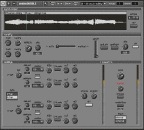
4-tap dub monkey
this is the result of professor sowari helping me transmogrify duBByk into a "real" dub monkey.
***
duBByk v1.5
By rick scott
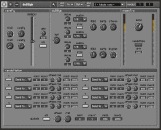
abstract quadruple delay
quadruple delay with optional rarefy
.
was supposed to have been a dub delay, but it's much better as an abstract delay. dub version: dubbleDUBBLE.
too dense to sound good with most beat loops, but works really well with solo voice.
***
DuckDub v1.0
By Dieter Zobel
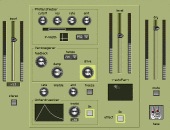
dynamisches echo-geraet,
please do not expect perfection
***
Samplers
gNash raMbler v1.6
By rick scott
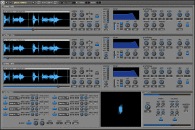
YARSM (yet another randomated sample mangler)
yet another randomated sample mangler!? sorry, but i couldn't resist. based on an oldie but goodie, GrainSynth.
please read the usage notes (popup for the instrument).
if you run into cpu load problems (and you probably will), just turn off
one or two raMblers. you'll miss out on some density, but the flow will be more interesting.
***
PC-909DM v1.2
By Patrick Cooper

Drum Module based on the TR-909 Soundset
The 'PC-909DM' is a Drum Module version of my original 'PC-909 Enhanced Rhythm Composer', that has been available in
this library for a couple of years now. (Sequencers, Percussive, Sample-based)
The PC-909DM differs because it omits the built in step sequencer of the original.
I have modified the PC-909DM in response to a number of criticisms about the original PC-909 being difficult to use in a host
sequencer, due to erratic and poor tempo sync. Indeed, I have never used it in any of my own compositions for this very
reason.
The PC-909DM should now be much easier to integrate into a host, MIDI can now be programmed by keyboard (Drum
sounds mapped from C1 to A2)
In this way the PC-909DM is similar to the Novation Drumstation, as it is utilised as a basic sample based sound module.
***
Specials
ParaWahn4 v1.0
By Dieter Zobel

Produktpflege,
emittiert wenig CO2 bei Batteriebetrieb
***
SOKOLOV Manufaktur V2 v2.1
By Tom Zellweger
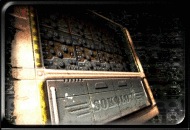
Samplebased LoopConsole / Standalone!
cpu: moderat / screen: big
helpful: use the infocurser
specifications:
4 units with 16 machineloops
each unit with settings for pitch, filter, amplifier,
2 delays and 5 modulationPoints
2 submixers
1 mastersection
1 globalsection with mastertempo and solobus
16 lfo's with serveral waveforms
the story of sokolov model 2211 can be traced back to the waning years of the last century!
my job as a mecanician in many(sometimes truly dusty) workshops and factories with toons of old mecanic equipment
leads me over the time to a total fascination:
the mystic, hypnotic sound of automated tools...
...and maybe there might be some other like minded people out there!
***
teN + frieNd v1.0
By Jim Hurley
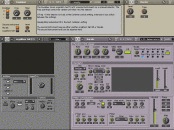
orgaNism 10 and a frieNd
This is a simple two instrument combiner which ring modulates the output of rick scott's fabulous orgaNism 10 with another
instrument.
You can choose between Auralis or another orgaNism 10.
***
Synthesyzers
Eminent-V 310 Strings Ensemble v1.0
By Hugo Portillo
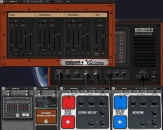
Emulation of the strings ensemble section of the Eminent 310 Unique/Theatre Organ
After I finished my Solina emulation I was pretty much satisfied with this string ensemble emulation thing. But on May 2007 I
read this article: http://www.soundonsound.com/sos/may07/articles/eminent310.htm
Then an idea started to build in my mind: create an emulation of this mighty machine, the Eminent 310 organ.
At first my goal was to recreate the whole organ, but after months and months of experiments, research,
and trial and error I set a more modest goal: to emulate just the strings ensemble section of it.
Now, after 8 months of work here it is. It has some improvements over my Solina-V:
better oscillators and an improved chorus unit.
Description:
Basically this instrument emulates the upper and lower manuals of the strings ensemble section.
Also, it adds a pedal section
for monophonic bass lines.
This is based on the Solina SE not on the 310.
Each section has a keyboard split, independent MIDI channel and transpose up to +-3 octaves.
Another difference is that I created envelope controls for each string registers
to further tweak the sound. I
f you want a truly 310 behavior leave the envelope sliders at their default values.
The effects section has the standard macros from the library with a different face (Graphic 10 EQ, Micro Space, and
Kleinstein Phaser), except the delay which is a cut down version of Michael Wöstefeld’s Michats Space Echo ME-201.
Use the A/B views to switch to the back panel controls to further tweak the sound.
WARNING: With all the effects and manuals on you with get a high CPU usage (+60% on a Pentium D 3.0 GHz)
I made a lame demo going thru most of the presets, everything played live, except Oxygene 6 which is sequenced; therefore,
please forgive my lousy playing :-)
If you ever tried to get that “Jarre sound” with this you can get very close.
I would like to thank the following:
- Mark Smart, for his wonderful ARP Omni 2 emulation from which I based the oscillators and chorus units of the Solina-V
and Eminent-V 310 => http://www.marksmart.net/
- Radek Tymecki, who kindly provided me with samples of his Eminent 310 and feedback to tweak the oscillators and chorus
unit of my instrument => http://www.youtube.com/profile?user=RadekTymecki
http://www.jeanmicheljarre.pl/
- Jürgen Haible, for his JH’s String Ensemble/Triple Chorus Solina chorus unit emulator.
Wonderful piece of hardware =>
http://www.jhaible.heim.at/triple_chorus/triple_chorus.html
- Hertz SM, for his Flat Knobs => http://www.native-instruments.com/index.php?
id=userlibrary&type=0&ulbr=1&plview=detail&patchid=3837
- g200kg, for knobman, great utility to create animated knobs and sliders ==>
www.g200kg.com/archives/software_knobman_e.html
***
Minimood R5 v5.1
By Jonathan Style

Skin for Minimood + Snapshots + Freakbox
This is a skin for the classic R3 Minimood from the Legacy Library. In order to make this skin I made several alterations to the
original instrument to suit my needs for the skin. Snapshots you may have developed will not work in this version but can be
easily adpted if you keep the changes I made in mind.
Changes that I made to the original Minimood:
1. I replace the pitch and gate handling with the Mono GP from the ’Voice Mode’ macro found in the R5 macro’s section.
2. The switch for Octave Range and Wave selection have been reversed to function with a knob. The switches are still there
they are now controlled by the knob via an IC send.
3. I have changed the instruments macro’s from Poly to mono.
All other features remain the same as the original.
There are two skin types to choose from. Panel A has the classic layout of the Minimoog but is boxed to conserve space. In
Panel B I have attempt to create an emulation of the Classic Minimoog in total (see screenshot above).
On the panel B view,
the pitch and modulation wheels are mouse controllable, the keyboard, however, is non-functional.
There are two snapshot banks. The first bank provides 80 snapshots.
The second bank is designed by Sowari (Phil Durrant)
providing 42 snaphots.
I added a humble attempt at the moogerfooger Freq Box. I am not competent with effects so forgive me if it's not very good.
There is now and lfo modulation to Frequency, on panel B side.
V5 update: I fixed the spelling error in the memorial to Bob, and I also fix the bypass lamp in the freakbox.
The knobs are created in Photoshop CS3 and rotated in g200kg’s Knobman, converted to TGA in XnView. All other objects
are created in Photoshop.
Note: the minimood and Freakbox are run to seperate mono channels (see mixer).
There are snapshot to hear one or the
other.
And this will be the last update for awhile.
***
Propane v1.1
By Jonathan Style

attempt at a Pro-One...or just another bass synth
Here may humble attempt at a SCI Pro-One. There are a few features that need to be explained. The arpeggiator has a play
and record option. In Record mode it function like a latch, whatever notes are held at the time it is activated these will
continue to play till it is turned off. The LFO section as a gate sync option, however this is not useable if the LFO is being
used as a clock source for the arpeggiator. In the modulation section there is a switch “12X” this increase the Filter envelopes
effect wherever it is routed.
There are several snapshots. Bank 1 is designed by Sowari (Phil Durrant). Bank 2 is designed by Jonathan Style.
Special Thanks to Sowari for suggesting this project, and for his continual response to my many posts of this synthesizer.
v1.01 Added moe snapshots from Sowari and I added some more as well.
***
Staubsauger v1.2
By Simon Klapper

Emulates the "WhatThe?" (Hoover) patch of the Roland Alpha Juno-2 Synth.
This simple instrument tries to emulate the "WhatThe?" (Hoover) patch of the Roland Alpha Juno-2 Synth.
It simply combines six detuned sawtooth oscillators in a way that sounds like three pulsemodulated square oscillators
(subtractive is combined with additive synthesis).
To create the typical pitch gliding there is also a pitch envelope that gives you a more constant sound control than the glide,
wich also is included.
Use the Filter and the Chourus effekt to create even fatter sounds.
***
WF Synth v1.0
By Petr Martínek
![]()
WF Synth (WFS) is a very simple analog synthesizer with wide range of sounds.
Use sampling frequence as high as possible to get clearer sound. Minimum is 44 kHz.
***
